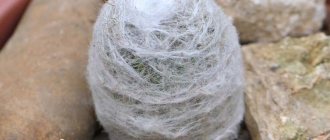Cacti are common inhabitants of home window sills, tubs and flowerpots; they often decorate office and other premises, fitting into almost any interior. This large family consists of succulents varying in size, appearance and climatic needs, but they are all united by relative unpretentiousness and vitality.
Caring for cacti is not difficult; most often, care consists of a minimum of procedures - watering, fertilizing, providing a microclimate depending on the season, and rare transplants. But, some varieties also need pruning. How to prune a cactus, which type of cactus is necessary, and in what cases can you not do without it?
When is the procedure necessary?
It is possible to prune cacti, and in some situations this is the only way to save an exotic plant. Most often, pruning and re-rooting is carried out in the following cases:
- The succulent is affected by rot.
- The cactus is significantly deformed, a strong distortion is noticeable.
- He began to grow rapidly and stretch out.
Living in extreme conditions, the plants acquired strong immunity. However, finding themselves in unusual conditions and not receiving proper care, they become vulnerable to pathogenic flora and pest attacks. Wintering in a warm place, excessive soil moisture, and lack of lighting weaken the succulent, reducing its ability to resist parasites and pathogens.
The cactus begins to rot for the following reasons:
- Due to waterlogging of the soil.
- Flower growth in an unsuitable soil mixture - too dense, greasy, and retaining moisture.
- If the container is too spacious, water will stagnate in it.
- As a result of plant infection by pathogenic fungi or bacteria.
To prevent the spread of putrefactive processes, it is recommended to trim the succulent, otherwise the specimen will die. In addition, this method can be used to correct the shape of a cactus, but only if there are no other options.
Is it possible to do this?
It is possible to prune cacti, and in some cases it is simply necessary.
It may be necessary to trim and re-root a cactus for various reasons, but most often this happens in cases where it is necessary:
- The plant begins to rot.
- The shape changes, the plant is greatly skewed.
- He has grown and stretched out a lot.
Cacti get sick due to inept care, pests or inappropriate treatment . Warm wintering, excessive watering or lack of light can seriously weaken the plant and reduce its ability to resist diseases and pests. To prevent this from happening, we suggest reading about how to properly water this plant and what is the best place to choose to place your green friend.
Rotting can begin due to:
- Overflow.
- Unsuitable soil (all details about choosing soil can be found here).
- A pot that is too large and where water stagnates (how to choose a pot for a cactus?).
- Due to fungal and bacterial infections.
Cacti that can and should be trimmed
Many cacti grow well throughout their lives without pruning. But some varieties still need it:
This spherical fatty comes from Paraguay and Argentina. It has quite successfully adapted to home conditions and has gained popularity among gardeners. The stem of the succulent is brownish or gray-green in color and has well-defined triangular ribs.
Gymnocalycium Mikhanovich requires grafting, for which it is pruned.
The stem of this spherical plant is completely covered with spines, for which it is nicknamed the “hedgehog cactus.” It grows in Mexican deserts, the growth process is slow, but specimens often reach 3 meters in height.
A succulent is not pruned to make it decorative, but only if its stem or root is rotten.
A South American cactus with columnar or lodging ribbed stems. One of the representatives of the genus Cleistocactus, which is also called “white candle”.
With the help of pruning, the succulent is renewed or reanimated.
The most numerous genus of cacti, the representatives of which were mentioned by the Aztecs. It is not difficult to recognize prickly pear among indoor plants - the plant has numerous flat leaves, shaped like feet or palms, covered with sharp spines - glochidia.
Prickly pear is pruned for many reasons, but most often the event is carried out to preserve the beautiful decorative shape of the succulent.
This cactus consists of a columnar stem that begins to branch as it matures. On the surface there are large areoles with long yellow spines. Blooms with white funnel-shaped flowers.
Caring for this species of Trichocereus also includes pruning: to rid the specimen of numerous children, reproduction, and also to remove parts affected by parasites or infections.
One of the most common genera of cacti, it is also quite numerous and includes almost two hundred species. Mammillaria are unpretentious, suitable for novice cactus growers and readily bloom at home.
It is possible and even necessary to prune this succulent if it has grown too much or is deformed.
These spherical plants are loved for their pretty appearance and beautiful flowering. What distinguishes Otto from other notocacti is the presence of well-defined, deep ribs. It blooms with yellow flowers, but varietal succulents with flowers of other shades are also bred.
Using pruning, flower growers prevent the plant from stretching; they cut off the top of the stem, which has reached a height of 17-18 cm, and sharpen the cut area so that it does not retract inward.
At home, in Mexico and the southern United States, these branched cacti are called “cholla.” Their stems consist of a large number of oblong segments, which grow profusely both in the natural environment and when grown at home. They are regularly pruned for hygienic purposes, as well as to give and maintain the neat shape of the succulent.
The Cereus genus includes fifty species, and some of them are successfully grown as home flowers. These tree-like cacti have a massive stem, in nature growing up to 20 meters in height, from which multiple shoots extend.
Appropriate timing and recommended frequency of pruning
Any cactus procedures are more difficult to tolerate during the winter period, when they fall into a state of stagnation. Their rooting and restoration proceed more slowly, and due to decreased immunity, they are more often attacked by pests and develop infectious diseases.
But if hygienic manipulations can be planned for a more appropriate time, then the sick succulent is pruned without delay. This measure is forced. In other cases, it is advisable to carry out pruning during the active growing season, that is, in spring and summer. Trimmed cuttings will take root faster, and the mother specimen will more easily endure the operation and will not die.
This is interesting! Many gardeners advise pruning indoor flowers during the waning moon.
Most of these succulents do not require regular pruning. But, it depends on their variety and growth rate.
Signs that a cactus needs pruning
Some changes in the condition of the succulent signal that it urgently needs a hygienic, and sometimes therapeutic, procedure - pruning the top:
- The skin turned yellow and lost its shine.
- The succulent lost its turgor, shrank, and looked sideways.
- The trunk and/or foliage are covered with spots - wet, dry, depressed, of any color and size.
- The cactus is growing slowly or this process has slowed down significantly.
- The specimen has become too tall and heavy, it seems that its pot is about to tip over.
- The top of the head rests on the ceiling or other upper surface, and it is not possible to move it to where there is room for subsequent growth.
In any of these cases, pruning will benefit your exotic pet.
Preparation and carrying out the procedure
Before pruning, you need to prepare tools and materials:
- a knife with a sharp, sterilized blade;
- gloves;
- spatula;
- charcoal powder for dusting the cuts.
And if the cut parts take root, then the soil, containers, drainage, etc.
- You need to make a cut from the old copy. If its length is 15 cm or more, it can be cut from the crown. It is more convenient to trim short specimens by removing them from the ground.
- The cut is carefully sharpened, much like when sharpening a pencil. The size of the peg can be only 1.5-2 cm. If this is not done, the soft tissues will dry out and be retracted. The flat surface of the cut will take the shape of a reverse funnel after a few days. And it is very difficult to root such a piece; improper deepening can lead to rotting of the stem.
- The upper part of the succulent is cut off with a blade, approximately 6-8 cm. If the stem is rotten, then all parts affected by rot are cleaned out, otherwise the rotting of the cut plant will continue.
- The sections are sprinkled with charcoal or activated carbon powder, this is especially important if a rotten stem or shoot was removed. Dispersed sulfur can also be used for these purposes.
After the event, the mother plant should be protected from direct sunlight; it needs light, but diffused. In addition, it is not recommended to water it immediately; you can do this after 3-4 days.
Top planting
The top is rooted by air drying for several days until the edges are tightened. There is no need to fear that without moisture and soil the succulent will die; drying is required for subsequent planting. After this, the stem is planted in soil consisting of 3 layers - drainage, soil and sand.
The soil should be moistened periodically and ensure that it does not dry out completely. After some time, the cuttings will take root and begin to grow.
Which pot to choose for replanting a cactus
For the procedure to be successful, you need to take care of a properly selected pot. With each new relocation of the crop, the container increases in diameter by 3 centimeters. For Astrophytums, Obregonias, Aricarpus, Azteciums - by 1-2 centimeters.
Also, when choosing a container, several other important parameters are taken into account:
- fibrous rhizomes are placed in wide pots;
- developed roots - in deep containers.
The culture must have complete freedom, otherwise the rhizome will begin to change, which will lead to the death of the cactus.
The material of the new container does not matter - both clay and plastic options are suitable. This allows you to select pots both in shape and color palette, based on your own preferences.
You can also learn how to create pots for cacti and succulents with your own hands.
Which species need it most?
What types of cacti require pruning most often? Most often you have to prune the following varieties of plants :
Gymnocalycium Michanovich
It has a thick, elongated stem covered with triangular ribs and is brown or grayish-green in color.
Echinocactus
A spherical plant, grows slowly, is unpretentious.
Cleistocactus Strauss
Horizontal columnar plant, grows up to 1 m in height. A special feature of the cactus is its closed tubular flowers .
Prickly pear
It grows up to 30 cm, has many small, very sharp spines.
Whitening Trichocereus
The stem grows vertically, or at a slight angle. It is distinguished by large white funnel-shaped flowers.
Mammillaria
Mammillaria are covered with long soft spines and have a cylindrical or oval shape.
Notocactus Otto
It has a thick stem with pronounced edges on which hard spines are located.
Cylindropuntia
A branched cactus, the stem consists of many oblong segments. Grows up to 1–2 meters at home.
Cereus
A tree-like cactus with a massive stem and many shoots.
Is it possible to trim the top of the Pachypodium?
Sooner or later it becomes necessary to prune the pachypodium (Madagascar palm). In favorable conditions, the plant can stretch almost to the ceiling. If you want to curb the growth of pachypodium, carefully trim the top of its head, which can then be rooted. The main stem will give off side shoots.
Interesting materials:
Is it possible to move checkers backwards? Is it possible to wear shorts to the military registration and enlistment office? Can balsamic dressing be stored in the refrigerator? Is it possible to store gasoline in an apartment? Is it possible to store receipts? Can I store files on an SSD? Is it possible to store gel polish lying down? Can a guitar be stored horizontally? Can I store my guitar in a case? Can the prepared smoothie be stored in the refrigerator?
When and how often to produce?
Rooting of cacti is most difficult in autumn and winter , when the plant is in a state of stagnation. But unfortunately, it is during these seasons that the plant’s immunity decreases and it is attacked by fungal and bacterial infections. Most often, the situation develops in such a way that pruning followed by rooting is the only way to save the plant from death.
If circumstances do not force you to immediately save the prickly succulent by pruning, you should wait until spring or summer. Cuttings cut this season will take root better, and the mother plant will survive.
How do you know when pruning is needed?
There are a number of external signs that allow you to understand whether the top of the plant can be trimmed:
- The skin turned yellow and stopped shining.
- The plant shrank.
- The cactus looked sideways.
- Spots appeared on the trunk (wet, dry, different in color and structure from the rest of the plant).
- Stopping growth and falling off during the growing season.
- The plant has become too long, heavy and threatens to overturn the pot.
- It rests on a shelf, a window sill, there is not enough space for it, it is not possible to move it to another.
Step-by-step instruction
Before you start pruning your cactus, prepare everything you need for this process . You will need a sharp, thin knife (a stationery knife can be used), an alcohol solution for disinfecting tools, charcoal powder, a pot and soil for the plant. Don't forget to prepare a thick towel or plastic tweezers - this will make it easier to hold the thorny trunk during the process.
The following plan describes how to prune a succulent at home:
- Select the mother plant that you will prune. If the length of your cactus exceeds 15 cm, start pruning immediately from the crown. If the plant is small, first remove it from the ground - this will make it easier to carefully make the cut.
- Disinfect the knife, and, grabbing the plant, carefully cut off the desired part. The larger the resulting cutting, the better.
- Inspect the cut - the tissue should be healthy, without lesions.
- Sharpen the cactus to the shape of a pencil. Don't sharpen too sharply, it's not necessary. This is done due to the fact that when dried, the protruding center will be drawn inward.
At the center of any cactus is a cambial ring. It must not be touched when sharpening!
- Treat the cut with crushed coal - the powder will absorb the protruding juice.
- Leave the cut cactus in a dry place out of direct sunlight. Drying time ranges from 1 to 4 weeks. It is best to dry the stem vertically.
- Next, you need to place the cut cactus on the ground (you cannot stick the shoot into the ground, it can rot) and place a few stones for stability.
- Place the pot in a sunny place and wait for the roots to appear. We wrote more about which place is best to choose to place a cactus in this article.
For a month, spray the plant only occasionally , and regularly inspect it for rot.
Care
For a month, spray the plant only occasionally , and regularly inspect it for rot.
You are engaged in growing cacti and comply with everything
care rules
looking after your prickly pet, but he doesn’t feel well, looks lethargic, or has he generally “hibernated”? The secret to the luxurious growth and flowering of a cactus is simple - it needs to be fed well and regularly. Read on the pages of our website about suitable fertilizers for this plant - what composition of vitamins is needed and
how to choose the right fertilizer
.
What to do if the plant dies after the procedure?
It is carried out according to the same scheme as the previous one - the plant is cut with a clean knife, sharpened into a pencil shape and laid out to dry.
When pruning, thoroughly clean the affected tissue . Even a small focus of infection will lead to recurrent disease.
If you take into account all the factors influencing the development of a cactus, you will ensure that the plant will regularly delight you with its flowering.
If you find an error, please select a piece of text and press Ctrl+Enter.
- - a sharp knife or blade;
- - plate;
- - pot for transplanting;
- — drainage;
- — soil;
- - sand.
- 5 Tips on How to Trim a Cactus
Improper care
The first and most common cause of death of cacti is improper treatment and inept or careless care. Reduced temperature on the windowsill, the harmfulness of a warm winter, improper soil - many have heard about this. But the water regime, which can confuse a novice gardener, is a completely different story.
It is known that cactus is a dry-loving plant. Therefore, many, for fear of ruining it, do not water the plant even during the period of strong growth on hot summer days. As a rule, such cacti lose their roots and are not able to survive the winter.
Everything about the need and correct technique for pruning a cactus
Cacti are extremely easy to care for and can grow on almost any windowsill without requiring close attention.
But sometimes there is a need to replant a cactus. If the cactus is bent, withers and refuses to bloom, it is necessary to prune it. This will help protect the plant from disease and excessive growth.
This article describes in detail the entire technology for properly pruning a cactus. The types of cacti that are most often subjected to the pruning process are presented.
The appearance of pests
The most common enemies of cacti are scale insects and red mites. However, fighting them is not too difficult, and preventing the appearance of pests is even more so. So, to prevent ticks, 4 sprays with ether sulfonate should be carried out annually. Only 1-1.5 g of insecticide is required per 1 liter of water. This product kills both tick larvae and eggs.
Unlike a tick, it is much easier to detect a mealybug, because it is much larger. The eggs of the mealybug resemble pieces of cotton wool in appearance, so it is difficult not to see them. You can remove the pest using thin tweezers or a damp brush. After this, the leaves of the plant should be washed, and the affected areas should be wiped with a cloth moistened with alcohol or a piece of gauze. However, to prevent alcohol from burning the stem, after lubricating the plant, you need to remove the cactus for 2 days in a dark place, away from sunlight.
Diseases
The most well-known cactus disease is late blight, which can quickly destroy this plant. The root collar is the most susceptible to rotting, and therefore you should periodically carefully inspect it for any damage.
In addition, diseases can occur in unventilated or damp areas. Most often, rot affects “fattened” and loose cacti with a watery stem and thin skin. If rot appears on the plant, it must be cut off immediately with a knife. Then you need to sprinkle this place with sulfur.
The most dangerous diseases of cacti are those that cause depressed dark spots to form on the stem of the plant. In most cases, such spots are covered with a velvety coating. A cactus disease such as diplodia also begins with the appearance of spots, but there is no plaque.
It is quite difficult to fight such diseases. It is recommended to simply get rid of infected cacti and also carry out disinfection.
What is the name of a cactus with colored needles?
Important! On sale you can see unusual cacti with colored needles
- red, purple or pink - and the name Echinocactus Gruzoni (usually a word corresponding to the color of
the needles
, for example “red”). However, it is known that in nature, Echinocactus needles can be either golden or white.
Interesting materials:
How to use Anew energy boost? How to use Apple PEN? How to use lip balm in a jar? How to use chromecast built in? How to use the instax MINI 11 camera? How to use a gas lighter? How to use the Accu Chek Performa Nano glucometer? How to use a group in telegram? How to use Google Lens? How to use Yandex navigator on foot?
How to protect cacti from rotting
Cacti are drought-resistant plants. Therefore, with improper care, which is characterized by excessive moisture, they easily rot and may die.
It is best to make a single composition of cacti and care for them as a whole. Plants in the composition should have the most similar requirements for soil composition, temperature conditions in winter and summer, humidity levels and the amount of water consumed. Joint placement will not only allow you to control the level of soil moisture individually for each plant, but will also protect them if one of the plants gets sick.
Next to the cacti, to make the whole composition more decorative, you can lay out several beautiful pebbles of various shapes, sizes and colors. And a large stone placed in the center of the composition will not only be an interesting decorative solution, but also great convenience when watering - water can be poured directly onto it, which will preserve the soil from erosion and ensure uniform distribution of moisture.
When should you prune a cactus?
People often ask, is it necessary to prune a cactus and under what conditions? In principle, this type of flower, like others, requires certain conditions for productive growth and development. Cactus pruning is necessary, but under certain conditions.
You need to prune a cactus if:
· The flower began to rot;
· Has an irregular shape and large growths;
· The plant has grown a lot.
It is worth understanding that a cactus can begin to rot due to improper watering and care. If the plant has a too large pot, then an excess of liquid can lead to the beginning of the rotting process. In such cases, the only option to solve the problem is circumcision.
Plants that have developed large shoots that warp and distort the main flower also need pruning. Or you will have to prune the cactus when it is too elongated and has an unstable trunk.
However, the process of circumcision is quite complex and painstaking, so it must be carried out with maximum responsibility.
Joint cultivation of cacti
Expanded clay is poured into a large flat container and pots with cacti are placed on it. When the composition looks natural and most attractive, the pots with cacti are slightly pressed into a layer of expanded clay, and all the free space between them is filled with soil for succulents, which can be purchased at any flower shop or made from equal parts of turf soil and coarse river sand. The soil is compacted around the pots, trying not to leave voids. The height of the soil layer should be equal to the height of the pots.
After planting, the cacti are not watered for 7-9 days, placing them in a well-lit place, but without direct sunlight.
How to root a broken cactus?
Now your cactus
you need to cut it off to a whole part with a knife, sharpen it “like a pencil” from below and put it on
rooting
.
Only this without a can. put drainage down into the pot, soil on top, and the top layer is DRY sand. Water occasionally from a tray, this way the soil is moistened but not wet, and the cactus
will not rot.
Interesting materials:
What happens if you swallow a battery? What happens if you swallow part of a tooth? What happens if you swallow dry ice? What happens if you lose to Gunther and Dima? What happens if you pierce your eardrum? What happens if you swear on Forgiveness Sunday? What happens if the battery on the motherboard runs out? What happens if you eat batteries? What happens if you eat the lead of a regular pencil? What happens if you eat sour soup?
Watering during dormancy
Cacti, like all plants, have a dormant period when they must rest and gather strength for spring growth and flowering. Therefore, with the onset of cold weather and the beginning of the heating season, cacti require a mandatory wintering with a minimum level of air humidity, a low temperature (up to +8...10°C) and very rare watering.
Cacti should remain in such conditions until spring. During this period, the formation of flower buds occurs. Flowering does not depend on watering, which should not be rushed in the spring either. During the period of awakening and the appearance of buds, it is recommended to lightly spray cacti with melt water. This will avoid their rotting, excessive and disproportionate growth at the very beginning of the growing season, and also preserve the beauty and harmony of your composition.
How to transplant a cactus into a larger pot?
Holding the cactus in the center, spread the roots in a circle, then begin filling in the soil. When the pot is almost full, you need to vigorously tap its sides or press the surface of the substrate with your hand. The remaining top layer of the pot can be filled with decorative crushed stone or expanded clay.
Interesting materials:
Can I pay for bus fare with a card? Can cardboard be composted? Is it possible to ride a bicycle without hands? Can Kazakhstanis travel to Russia in 2022? Is it possible to eat cranberries every day? Can I pay with halva in any store? Can henna be diluted with oxide? Is it possible to go to the cemetery until 40 days after death? Is it possible to go to the cemetery the week before Easter? Is it possible to walk on tiles after 12 hours?











